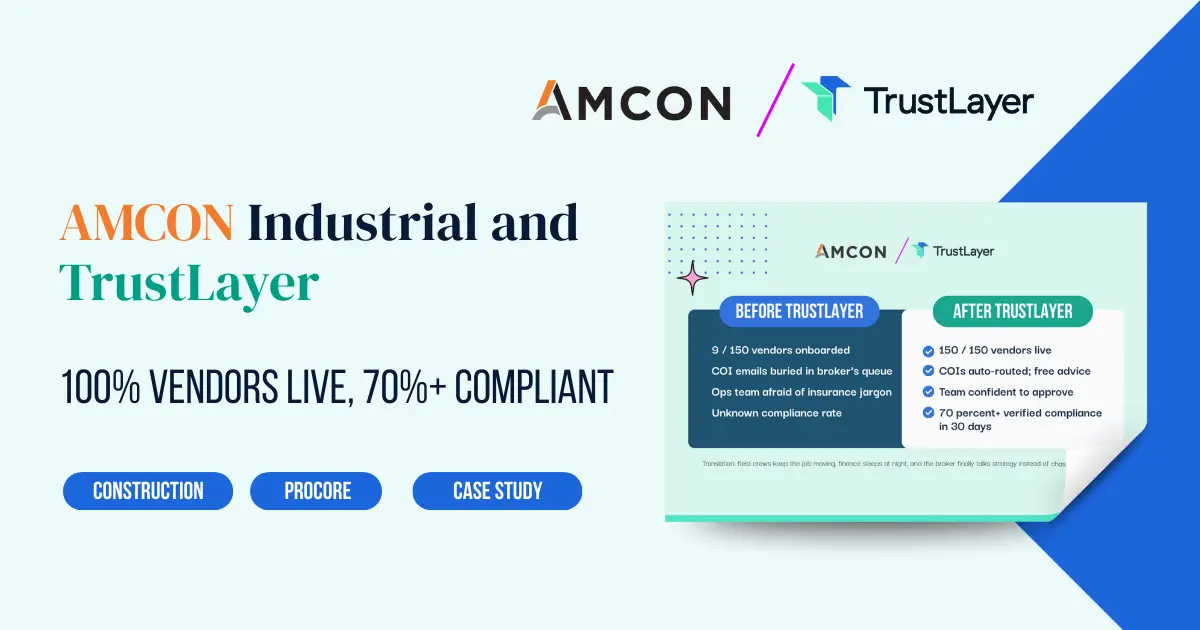The Risks of Manual COI Tracking
In today's fast-paced business world, managing risks and ensuring compliance is crucial for the success and reputation of any organization. One area that often flies under the radar but poses significant risks is Certificate of Insurance (COI) tracking. Many businesses still rely on outdated manual processes to manage their COIs, unaware of the hidden dangers and potential consequences they may face.
Understanding COI: A Brief Overview
Certificate of Insurance, commonly referred to as COI, is a document that provides proof of insurance coverage for a particular risk or activity. Whether it's liability insurance, property insurance, or workers' compensation, COIs are essential for businesses to protect themselves and their stakeholders. Understanding the definition and importance of COI is crucial in recognizing the need for accurate tracking and management.
Definition and Importance of COI
A COI is a document issued by an insurance company or broker that outlines the terms and conditions of an insurance policy. It includes critical information such as policy limits, coverage types, effective dates, and the named insured. Businesses often require COIs from their contractors, vendors, and partners to assure they have adequate insurance coverage.
Proper COI management is crucial for minimizing risks. Without accurate and up-to-date COIs, businesses may expose themselves to financial liabilities, legal disputes, and reputational damage.
When it comes to liability insurance, COIs provide businesses with peace of mind. They offer proof that the insured party has coverage for potential claims that may arise from their operations or services. This is especially important for businesses that work in high-risk industries, such as construction or healthcare.
Property insurance COIs, on the other hand, protect businesses against losses or damages to their physical assets. This can include buildings, equipment, inventory, and other valuable property. By requiring COIs from contractors or tenants, businesses can ensure that their assets are adequately covered in case of accidents, natural disasters, or other unforeseen events.
Workers' compensation COIs are essential for businesses that have employees. These COIs provide coverage for medical expenses and lost wages in the event of work-related injuries or illnesses. By requiring COIs from contractors or subcontractors, businesses can protect themselves from potential liability if an uninsured worker gets injured on the job.
The Role of COI in Business Operations
Beyond protecting against potential lawsuits and claims, COIs play a vital role in day-to-day business operations. From securing contracts and building client trust to mitigating risks and ensuring regulatory compliance, COI tracking is an essential component of responsible business practices.
When businesses engage in contracts or partnerships, they often require proof of insurance coverage through COIs. This requirement ensures that all parties involved are adequately protected in case of any unforeseen events or accidents. By verifying the COIs of their contractors or partners, businesses can mitigate the risk of liability and ensure that they are working with reliable and responsible entities.
Furthermore, COIs are crucial for building client trust. When businesses can provide proof of insurance coverage, it instills confidence in their clients that they are protected in case of any damages or losses resulting from the business's products or services. This can be particularly important for businesses in industries such as consulting, where clients rely on their expertise and advice.
COIs also play a significant role in ensuring regulatory compliance. Many industries have specific insurance requirements that businesses must meet to operate legally. By keeping track of and maintaining accurate COIs, businesses can demonstrate compliance with these regulations and avoid potential penalties or legal issues.
In conclusion, COIs are more than just documents that provide proof of insurance coverage. They are essential tools for businesses to protect themselves, their stakeholders, and their clients. Proper COI management is crucial for minimizing risks, building trust, and ensuring regulatory compliance. By understanding the definition and importance of COI, businesses can recognize the need for accurate tracking and management, ultimately safeguarding their operations and reputation.
The Traditional Approach: Manual COI Tracking
Despite technological advancements in various fields, many businesses still rely on manual methods when it comes to tracking and managing Certificates of Insurance (COIs). Let's explore how this traditional approach works and why businesses often stick to it despite the inherent risks.
In a manual COI tracking process, businesses typically receive COIs from their vendors, contractors, or partners via email, fax, or physical copies. These documents are then manually reviewed, recorded, and stored either in physical files or saved as electronic documents.
However, the process doesn't end there. In order to ensure compliance, businesses need to continuously monitor and update their COI records. This involves regularly reaching out to vendors and contractors to obtain updated COIs, verifying the accuracy of the information, and making sure that the coverage meets the required standards.
The key challenge with manual COI tracking lies in the dependencies on human efforts. Manual processes are prone to errors, oversights, and delays, leading to inaccurate or outdated COI records. This puts businesses at risk of working with uninsured or underinsured parties, which can result in unforeseen financial and legal consequences.
Moreover, the manual nature of the process can be time-consuming and labor-intensive. Businesses often have to dedicate significant resources to manage and organize COIs, taking away valuable time and effort that could be better utilized for core business activities.
Why Businesses Still Use Manual COI Tracking
Although manual COI tracking is inherently risky and inefficient, businesses often resort to it for various reasons. Limited resources, lack of awareness about automated solutions, and reluctance to change existing processes are some common barriers preventing organizations from adopting better practices.
Furthermore, the complexity of insurance policies, varying compliance requirements across industries, and the sheer volume of COIs to manage can discourage businesses from seeking alternative solutions. The fear of disrupting existing workflows and the perceived costs associated with implementing automated COI tracking systems can also contribute to the resistance towards change.
However, it is important for organizations to recognize the hidden dangers associated with manual COI tracking. The potential for errors and omissions in manual processes can expose businesses to significant financial risks, legal liabilities, and damage to their reputation.
Automated COI tracking solutions offer numerous advantages over manual methods. These include real-time tracking and monitoring, automated reminders for expiring COIs, streamlined communication with vendors and contractors, and centralized storage of COI records. By embracing technology, businesses can enhance their risk management practices, improve efficiency, and ensure compliance with insurance requirements.
In conclusion, while manual COI tracking may still be prevalent in many businesses, it is crucial for organizations to evaluate the risks and inefficiencies associated with this approach. By exploring and adopting automated COI tracking solutions, businesses can mitigate risks, save time and resources, and focus on their core operations.
The Hidden Dangers of Manual COI Tracking
Businesses relying on manual COI tracking expose themselves to several perils that can hinder their growth and stability. Let's uncover the hidden dangers that come with outdated processes and why organizations should consider an automated approach.
Inaccuracy and Human Error
Manual COI tracking heavily relies on human intervention, making it susceptible to inaccuracies and errors. Mishandling COIs, misplacing documents, or failing to update records promptly can lead to untracked policy changes or the use of invalid COIs.
According to industry research, an alarming 41% of businesses have experienced increased financial losses due to inaccurate or expired COIs. These errors have not only left them exposed to liabilities but have also damaged their reputation and client relationships.
Time-Consuming and Inefficient Processes
Managing COIs manually is a labor-intensive and time-consuming process. Businesses spend valuable hours each week coordinating with vendors, verifying information, and manually updating spreadsheets or databases.
Research suggests that companies spend an average of 13 hours per week tracking and validating COIs manually. As a result, vital resources are diverted from core business activities, affecting productivity and profitability.
Potential Legal and Financial Consequences
Outdated COIs or working with uninsured or underinsured parties can have severe legal and financial ramifications. In the event of an incident or claim, businesses holding invalid or expired COIs may find themselves liable for damages, medical expenses, or legal fees.
A recent survey revealed that 72% of organizations faced financial loss due to vendor-related issues, including improper insurance coverage. These incidents have cost businesses millions of dollars, highlighting the importance of comprehensive COI management.
The Impact of Manual COI Tracking on Business Performance
Manual COI tracking not only puts businesses at risk but also has a detrimental impact on their overall performance. Let's delve into the direct and indirect consequences organizations face by relying on outdated processes.
Effect on Operational Efficiency
The labor-intensive nature of manual COI tracking can hinder operational efficiency. Valuable time spent chasing COIs, verifying information, and rectifying errors takes away from focusing on core tasks and business growth.
Automating COI tracking allows businesses to streamline their operations by reducing manual efforts, minimizing errors, and improving overall efficiency. Shifting to automated systems frees up resources, empowering employees to focus on strategic initiatives and value-added tasks.
Implications for Risk Management
Effective risk management is an integral part of organizational success. Manual COI tracking inhibits risk mitigation by increasing the chances of working with parties that pose potential risks.
An analysis conducted by industry experts found that over 60% of businesses struggle to track changes in vendor insurance coverage. By implementing automated COI tracking systems, businesses can proactively manage risks and ensure compliance, protecting themselves from liabilities and preserving their reputation.
Transitioning from Manual to Automated COI Tracking
The need for change in COI tracking has become increasingly apparent in light of the risks associated with manual processes. Transitioning to automated COI tracking offers numerous benefits and positions businesses to thrive in today's ever-evolving landscape.
The Need for Change in COI Tracking
By recognizing the limitations and hazards of manual COI tracking, businesses can actively seek better solutions that address their COI management needs. It is essential to adapt to automated systems that leverage technology to streamline processes, enhance accuracy, and reduce risks.
Benefits of Automated COI Tracking Systems
Automated COI tracking systems provide businesses with a comprehensive solution to manage and reduce the risks associated with manual tracking. These systems digitize and centralize COI records, facilitating efficient verification, renewal tracking, and compliance monitoring.
Organizations that adopt automated COI tracking systems benefit from significant time savings, reduced errors, and improved risk management. Among the various solutions available, TrustLayer is a leading provider of automated COI tracking software trusted by businesses globally.
TrustLayer's platform utilizes advanced technology to simplify COI management, enabling businesses to work seamlessly with trusted partners. With features such as real-time verification and automated reminders, TrustLayer streamlines the entire COI tracking process, minimizing risks and improving operational efficiency.
Transitioning from manual COI tracking may seem daunting, but the benefits far outweigh the risks and challenges associated with outdated processes. Embracing the technological advancements available ensures businesses stay competitive, compliant, and protected in an ever-evolving business landscape.
It is high time for organizations to recognize the risks of manual COI tracking and take the necessary steps towards automated solutions. By prioritizing accurate, efficient, and proactive COI management, businesses can mitigate potential risks, safeguard their interests, and pave the way for long-term success.










.png)



